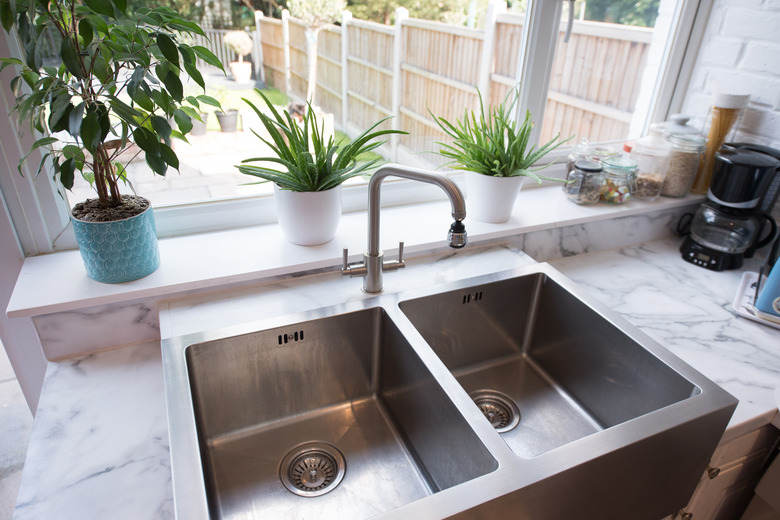Can You Put Bleach In A Stainless Steel Sink?
It's definitely possible to stain stainless steel, and one of the most notorious staining agents is chlorine. It does this in a fairly complex electrochemical process the details of which you probably aren't interested, but what should draw your attention is the fact that the staining, which is called pitting, is a type of corrosion and is permanent. It can dull the finish at best, and at worst, it can eat small pinholes through the metal.
This can happen with bleach products that contain sodium hypochlorite, which includes Clorox, but not so-called oxygen bleaches that contain sodium percarbonate or hydrogen peroxide. Before putting bleach in a stainless steel sink, read the label and put the bleach somewhere else if it contains sodium hypochlorite. There are safer ways to clean and disinfect stainless steel that are just as effective as bleach.
Clorox Recommends Bleach on Stainless Steel Appliances
Clorox Recommends Bleach on Stainless Steel Appliances
It's somewhat surprising to find the recommendation to use bleach on stainless steel appliances on the Clorox website. Perhaps the company has found no danger associated with occasional use, and it may be safe to use bleach on stainless steel that has a high concentration of molybdenum, which inhibits the corrosion reaction.
You can't be sure if the stainless steel in your sink contains the requisite concentration of molybdenum, however, so it's safer to avoid bleach altogether. This is even more important for a sink than for an appliance like a refrigerator because the bleach solution is more likely to pool in the bottom of a sink and cause more damage.
The Best Way to Clean Stainless Steel
The Best Way to Clean Stainless Steel
Appliance manufacturers and cleaning experts tend to recommend cleaning stainless steel with baking soda and a soft, nonabrasive cloth or sponge. Baking soda is a very mild abrasive that won't scratch the metal, which is something else you shouldn't do. If you scratch the surface of stainless steel and expose the metal underneath, it will rust.
Here's a recommended cleaning regimen for stainless steel sinks:
- Pour baking soda liberally on the bottom of the sink and add a little water to make a paste.
- Rub the baking soda along the polish lines of the metal, using a sponge or rag. Avoid rubbing across the polish grain because that can produce unsightly streaks.
- Cut a lemon in half and rub the exposed part along the polish lines to kill bacteria and deodorize.
- Rinse well with water.
Alternatively, you can clean the sink with vinegar. Pour some into a spray bottle, spray the sink and rub the vinegar into the metal, going with the polish lines, to remove stains and odors. Vinegar works especially well for water spots, but be careful. It's acidic, and if you let it stand in the sink, it can create stains of its own.
Don't Use Bleach as a Drain Cleaner in a Stainless Steel Sink
Don't Use Bleach as a Drain Cleaner in a Stainless Steel Sink
Bleach isn't a very good drain cleaner, but it does disinfect your drain. However, the bleach and stainless steel reaction mitigates against using it in a stainless steel sink. In fact, you shouldn't use it in any sink, no matter the material, if the sink has a stainless steel drain strainer or chrome P-trap.
Just as you can choose sink cleaners that are just as good as bleach, you can also choose drain cleaners that are just as good. The best combination, short of a commercial product, is baking soda and vinegar. Pour 1/2 cup of baking soda in the drain followed by a 50/50 solution of vinegar and water. The combination creates a foam that gives the pipes a deep clean without any fear of staining or corrosion.
